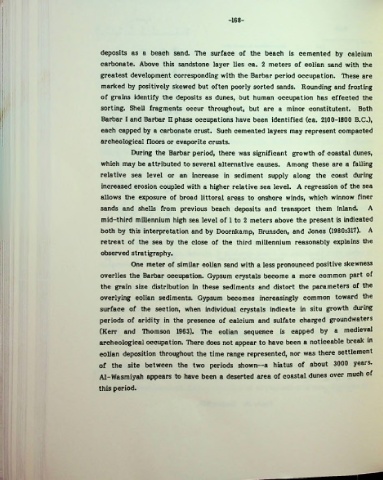Page 192 - Life & Land Use on the Bahrain Islands (Curtis E Larsen)
P. 192
;
-168-
deposits as a beach sand. The surface of the beach is cemented by calcium
carbonate. Above this sandstone layer lies ca. 2 meters of eolian sand with the
greatest development corresponding with the Barbar period occupation. These are
marked by positively skewed but often poorly sorted sands. Rounding and frosting
of grains identify the deposits as dunes, but human occupation has effected the
sorting. Shell fragments occur throughout, but are a minor constitutent. Both
Barbar I and Barbar n phase occupations have been identified (ca. 2100-1800 B.C.),
each capped by a carbonate crust. Such cemented layers may represent compacted
archeological floors or evaporite crusts.
During the Barbar period, there was significant growth of coastal dunes,
which may be attributed to several alternative causes. Among these are a falling
relative sea level or an increase in sediment supply along the coast during
increased erosion coupled with a higher relative sea level. A regression of the sea
allows the exposure of broad littoral areas to onshore winds, which winnow finer
sands and shells from previous beach deposits and transport them inland. A
mid-third millennium high sea level of 1 to 2 meters above the present is indicated
both by this interpretation and by Doornkamp, Brunsden, and Jones (1980:317). A
retreat of the sea by the close of the third millennium reasonably explains the
observed stratigraphy.
One meter of similar eolian sand with a less pronounced positive skewness
overlies the Barbar occupation. Gypsum crystals become a more common part of
the grain size distribution in these sediments and distort the parameters of the
overlying eolian sediments. Gypsum becomes increasingly common toward the
surface of the section, when individual crystals indicate in situ growth during
periods of aridity in the presence of calcium and sulfate charged groundwaters
(Kerr and Thomson 1963). The eolian sequence is capped by a medieval
archeological occupation. TTiere does not appear to have been a noticeable break in
eolian deposition throughout the time range represented, nor was there settlement
of the site between the two periods shown—a hiatus of about 3000 years.
much of
Al-Wasmiyah appears to have been a deserted area of coastal dunes over
this period.

